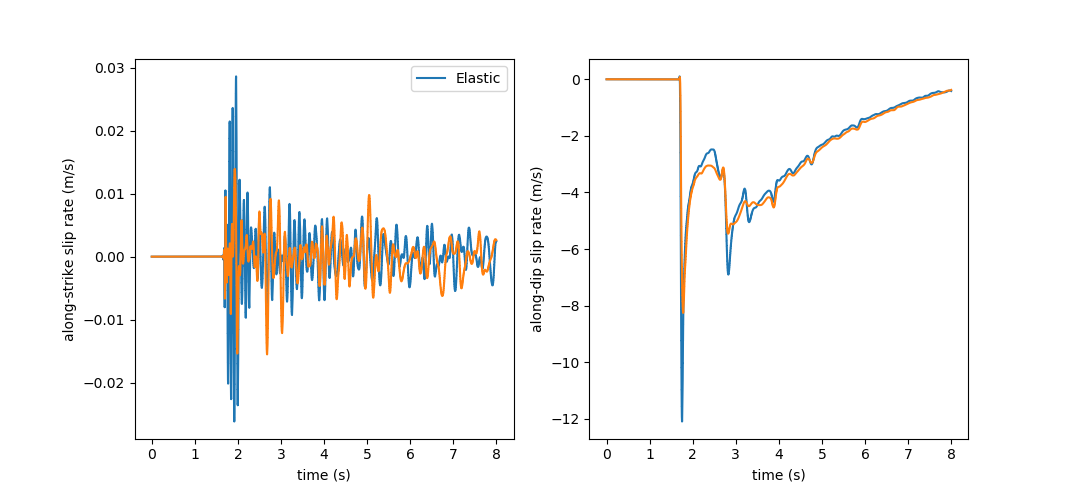SCEC TPV13
TPV13 is similar to TPV12 except for the non-associative Drucker-Prager visco-plastic rheology.
The Drucker-Prager yield function is given by:
\(F(\sigma)=\sqrt{J_2(\sigma)}-Y(\sigma)\)
\(Y(\sigma)\) is the Drucker-Prager yield stress, given as:
\(Y(\sigma) =\max(0,c\cos \phi - (\sigma_m +P_f)\sin \phi)\)
with \(\sigma_m = (\sigma_{11}+\sigma_{22}+\sigma_{33})/3\) the mean stress,
\(c\) the bulk cohesion, \(\phi\) the bulk friction and \(P_f\) the fluid pressure (1000 kg/m \(^3\)). In TPV13 benchmark, \(c=\) 5.0e+06 Pa and \(\phi\) =0.85.
\(J_2\) is the second invariant of the stress deviator:
\(J_2(\sigma) = 1/2 \sum_{ij} s_{ij} s_{ji}\)
with \(s_{ij} = \sigma_{ij} - \sigma_m \delta_{ij}\) the deviator stress components.
The yield equation has to be satisfied:
\(F(\sigma)\leq 0\)
When \(F(\sigma) < 0\), the material behaves like a linear isotropic elastic material, with Lame parameters \(\lambda\) and \(\mu\).
Wen \(F(\sigma) = 0\), if the material is subjected to a strain that tends to cause an increase in \(F(\sigma)\), then the material yields and plastic strains accumulates.
Nucleation
TPV13 uses the same nucleation strategy as TPV12.
Plasticity parameters
To turn on plasticity in SeisSol, add the following lines in parameters.par:
&Equations
Plasticity = 1 ! default = 0
Tv = 0.03 ! Plastic relaxation
/
Plasticity related parameters are defined in material.yaml:
!Switch
[rho, mu, lambda, plastCo, bulkFriction]: !ConstantMap
map:
rho: 2700
mu: 2.9403e+010
lambda: 2.941e+010
plastCo: 5.0e+06
bulkFriction: 0.85
[s_xx, s_yy, s_zz, s_xy, s_yz, s_xz]: !Include tpv12_13_initial_stress.yaml
Results
Figure 1 compares the slip-rates along strike and dip in TPV12 (elastic) and TPV13 (visco-plastic). The peak slip rate in TPV12 is higher than in TPV13. This difference can be attributed to the inelastic response of the off-fault material. See Wollherr et al. (2018) for detailed discussions.

Figure 1: along-strike (left) and along-dip (right) slip rate in TPV12 (blue) and 13 (orange).